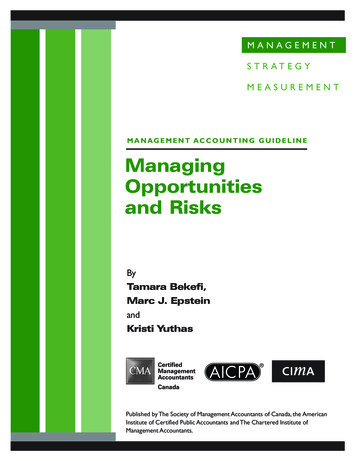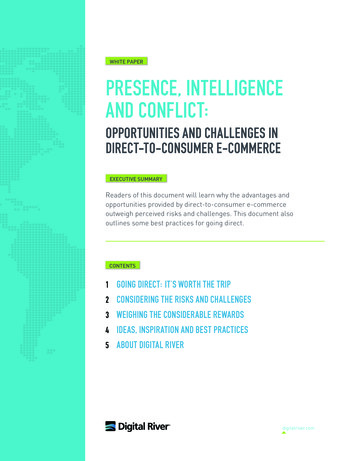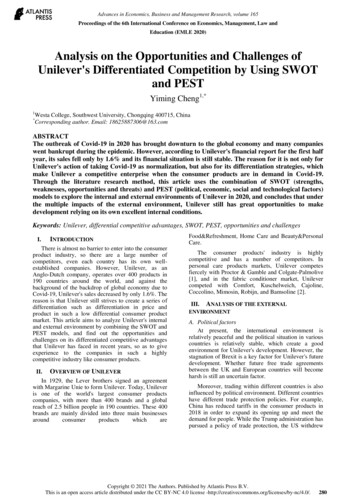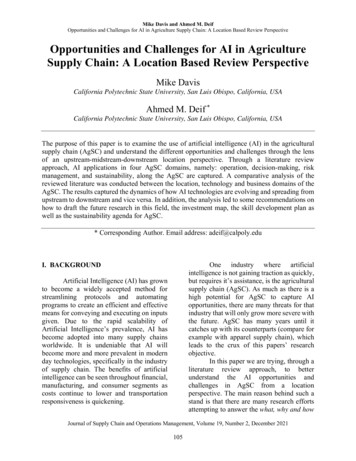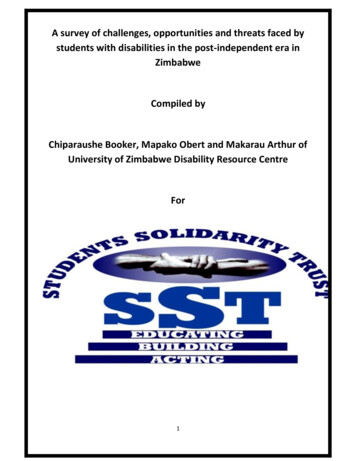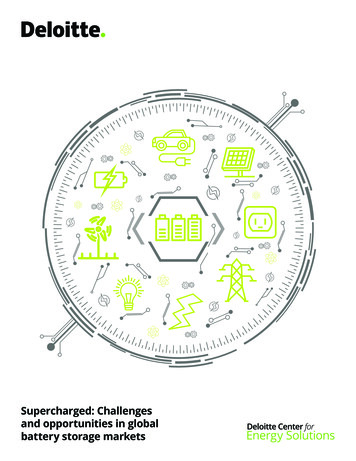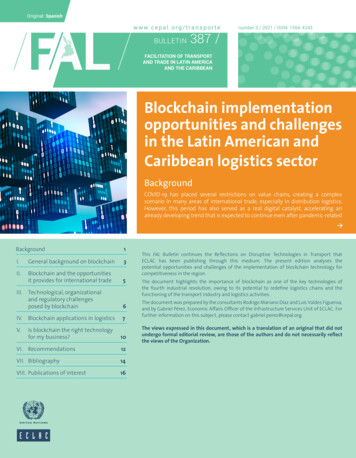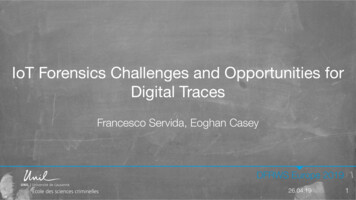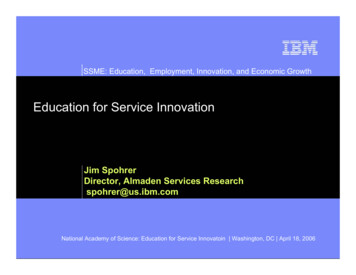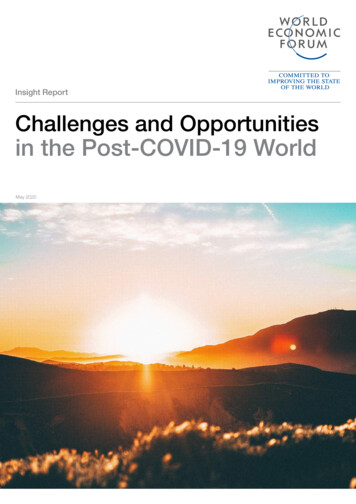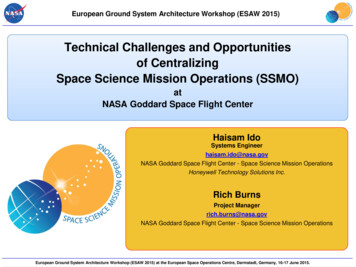
Transcription
European Ground System Architecture Workshop (ESAW 2015)Technical Challenges and Opportunitiesof CentralizingSpace Science Mission Operations (SSMO)atNASA Goddard Space Flight CenterHaisam IdoSystems Engineerhaisam.ido@nasa.govNASA Goddard Space Flight Center - Space Science Mission OperationsHoneywell Technology Solutions Inc.Rich BurnsProject Managerrich.burns@nasa.govNASA Goddard Space Flight Center - Space Science Mission OperationsEuropean Ground System Architecture Workshop (ESAW 2015) at the European Space Operations Centre, Darmstadt, Germany, 16-17 June 2015.
Where is Space Science Mission Operations (SSMO) ?SSMOsource: opean Ground System Architecture Workshop (ESAW 2015) at the European Space Operations Centre, Darmstadt, Germany, 16-17 June 2015.2
SSMO Organizationsource: opean Ground System Architecture Workshop (ESAW 2015) at the European Space Operations Centre, Darmstadt, Germany, 16-17 June 2015.3
What is Space Science Mission Operations (SSMO)? (1/2) SSMO operates, manages, administers and processes science datafor NASA space science missions for which GSFC is responsible SSMO is involved in the operations concept development, groundsystem development, integration and test, and operations readinesspreparations for those missions it will manage in the operationsphase. Spacecraft operations encompasses: flight operations (planning, scheduling, real time operations,automation, monitoring, etc.) instrument operations spacecraft sustaining engineering ground system sustaining engineering anomaly management risk managementEuropean Ground System Architecture Workshop (ESAW 2015) at the European Space Operations Centre, Darmstadt, Germany, 16-17 June 2015.4
What is Space Science Mission Operations (SSMO)? (2/2) SSMO currently manages the full mission operations for18 space science missions 7 are operated at GSFC 11 are operated at control centers at industrial anduniversity partners SSMO missions are diverse heritage/launch date orbit regime bus type mission profile communication networksEuropean Ground System Architecture Workshop (ESAW 2015) at the European Space Operations Centre, Darmstadt, Germany, 16-17 June 2015.5
SSMO Spacecraft in OperationsMissionLaunchYearMOC LocationScience Type# s/cOrbit RegimeCatalog 1LEOARTEMIS*2007UC BerkeleyHeliophysics2P1, lunar orbit; P2,Lunar Lagrange Point Heliophysics1HEO (T 9 anetary (Lunar)1Lunar OrbitN/AMAVEN2013LM - DenverPlanetary1Mars OrbitN/AMMS2015GSFCHeliophysics4HEOVan Allen Probes (RBSP)2012APLHeliophysics2HEO38752, 38753RHESSI2002UC 006APLHeliophysics2Heliocentricn/aSwift2004Penn StateAstrophysics1LEO28485THEMIS2007UC BerkeleyHeliophysics3HEO305880, 30584, Heliophysics1L1N/A3130430581, 30582n/a* ARTEMIS is a bifurcation of the THEMIS extended mission.** SOHO is a cooperative program between ESA and NASA.European Ground System Architecture Workshop (ESAW 2015) at the European Space Operations Centre, Darmstadt, Germany, 16-17 June 2015.6
Why centralize operations? Generally GSFC builds and maintains a different operation center per mission Consider whether centralization would enhance efficiency What are the costs and benefits of centralization, consolidation and/orintegration of a diverse set of operation centers, interfaces, services andprocesses There is no traditional or modern technical barriers to developing a centralizedcapability Operational efficiencies may be significantly enhanced with centralization andintegration May require significant investments in infrastructure Existence proofs exist: ACE, Wind, and TRACE (until decommissioning) were all operated fromSSMO's Multi-Mission Operations Center (MMOC) new centralization paradigms are enabled by modern technologiesEuropean Ground System Architecture Workshop (ESAW 2015) at the European Space Operations Centre, Darmstadt, Germany, 16-17 June 2015.7
SSMO Operations’ Functions1Telemetry, Tracking & Commanding (TT&C)2Data and Product Management Receiving Archiving Retrieving Modeling Trending Visualizing Distributing34Flight Dynamics Maneuver planning, execution andreconstruction Orbit Estimation Control Attitude Estimation ControlSubsystems Management Command and Data Handling (C&DH) Guidance Navigation and Control(GN&C) Instrument Subsystem Payload Subsystem Power Subsystem Propulsion Subsystem Thermal Subsystem5Scheduling and Planning Instrument Activities Maneuvers Antenna Availability AOS/LOS Shadows Sun/Moon Interference Ranging6Automation ManagementNotification ManagementLogging ManagementVoice Management7Information Assurance/Information Security8Change and Configuration Management Documentation & Procedures Spacecraft Configurations Ground Segment Configurations Software Configurations Server Configurationsplus Continuity of Operations of all these functionsEuropean Ground System Architecture Workshop (ESAW 2015) at the European Space Operations Centre, Darmstadt, Germany, 16-17 June 2015.8
Challenges and Opportunitiesnot discussed in l“Cultural”OperationalTechnicalEuropean Ground System Architecture Workshop (ESAW 2015) at the European Space Operations Centre, Darmstadt, Germany, 16-17 June 2015.9
Challenges in Centralizing Operations Cultural The mode of one operations center per mission has been effectively utilized in the past, i.e. it isprovenTendency to utilize heritage architectures, tools, methodologiesAre the benefits substantial enough to merit the investment/risk?Governance Governance is generally tied to the Flight ProjectWho governs a shared/centralized set of resources?Operational Operations is performed independently of other spacecraft operationsCross spacecraft and subsystems training is not commonTechnical Although many operation centers leverage very similar software and hardware yet they tend toimplement different architecturesRisk averse to newer methodologies and technologiesProgrammatic Requires initial investmentWhat flight project is willing to "be first" (and assume cost/risk)?European Ground System Architecture Workshop (ESAW 2015) at the European Space Operations Centre, Darmstadt, Germany, 16-17 June 2015.10
Opportunities in Centralizing Operations Cultural Familiarize staff with possible enhancements to current approaches and methodologiesCreate a more diverse and engaging place of workCreate more opportunities for collaborationGovernance Must enable freedom of choice while influencing/incentivizing standardizationOperational Perform spacecraft operations, with all SSMO spacecraft in mind, e.g. scheduling, etc.Train core staff across all spacecraft and subsystemsNormalize workflows and proceduresTechnical Continue to leverage similar software and hardware and normalize architectures andconfigurationsConfigure applications to be multi-tenant, when and where possibleShared infrastructure and overhead functionality (e.g. IT Security)Programmatic Establish compelling business case or discover that one does not existSo what would centralized operations look like compared to current modes?European Ground System Architecture Workshop (ESAW 2015) at the European Space Operations Centre, Darmstadt, Germany, 16-17 June 2015.11
Current and Future Operations EnvironmentsCurrentFuture**Characteristics One mission in one center* Unique infrastructure Unique product formats Custom networking interfaces Custom workflows Custom procedures Custom security implementations Dedicated hardware and software Dedicated staff Localized lessons-learnedCharacteristics Multiple-missions in one center Shared infrastructure Shared product formats Shared networking interfaces Shared workflows Shared procedures Shared security implementations Shared hardware and software Shared core staff Shared lessons-learnedConsequences Increased cost Replication of effort Lower efficiencyConsequences Reduction of costs in the long-term Reduction of effort in the long-term Improved efficiency in the long-term*: ACE & WIND are together in one operations center**: One possible pathEuropean Ground System Architecture Workshop (ESAW 2015) at the European Space Operations Centre, Darmstadt, Germany, 16-17 June 2015.12
Future Operations Environment** (continued)1 Personnel Resources Shared Human Resources Shared Skills Shared Expertise2 Project Management Shared Configuration Management Shared Document Management System Shared Documents Shared Knowledge Shared Lessons Learned Shared Cost Shared Procedures3 Physical Facility Shared Floor space Shared Rack space(s) Shared Terminals Shared Electrical power Shared HVAC Shared LANs & WANs Shared Interface Testing4 Broader CollaborationShared Governance Body5 Shared SecurityShared Risk6 Hardware & Computing Shared Computing Shared Physical Machines Shared Virtual Machines Shared Cloud Services Shared Memory Storage Shared Storage7 Software Simultaneous Multi-Execute without Interference(for Specific Functions) Shared Provisioning System Shared Version Control System Shared Applications & Tools Shared datastores and databases8 Commonality & Integration Integrated Situational Awareness Common User Experience (UX) Common User Interfaces (UI) Common Standards & Specifications Common Workflows & Operating Procedures Common Services & Interfaces as a Service approach (aaS) Web Services**: One possible pathEuropean Ground System Architecture Workshop (ESAW 2015) at the European Space Operations Centre, Darmstadt, Germany, 16-17 June 2015.13
Technologies, Architectures and Goals To Consider (1/5) Traditional Infrastructure Technologies Computing, Clustering, Redundancy, Storage, Networking Contemporary Services Web services Infrastructure as a Service (IaaS) Platform as a Service (PaaS) Software as a Service (SaaS) Software Defined Networks (SDN) Derivable Services such as Ground Segment as a Service (GSaaS) TT&C as a Service (TTCaaS) Mission Planning and Scheduling as a Service (MPSaaS) Space Flight Dynamics as a Service (SFDaaS) Database as a Service (DBaaS) Data as a Service (DaaS) Load Balancing as a Service (LBaaS)European Ground System Architecture Workshop (ESAW 2015) at the European Space Operations Centre, Darmstadt, Germany, 16-17 June 2015.14
Technologies, Architectures and Goals To Consider (2/3)Architectural Goals Scalable Extensible Maintainable Based on open standards Based on an open architecture Can run on virtualized or physical machines Leverage physical machines, virtual machines and cloud servicesEuropean Ground System Architecture Workshop (ESAW 2015) at the European Space Operations Centre, Darmstadt, Germany, 16-17 June 2015.15
Technologies, Architectures and Goals To Consider (3/5)Operations CenterPhysical Networks and Software Defined Networks (SDN)Hybrid inesEuropean Ground System Architecture Workshop (ESAW 2015) at the European Space Operations Centre, Darmstadt, Germany, 16-17 June 2015.
Technologies, Architectures and Goals To Consider (4/5)Integrated GroundSegment ControlSystem TT&C (m)TT&C (1)4.0Integrated Planning &Scheduling SystemFDS (1)TT&C (m)TT&C (1)2.0Integrated TT&CSystem3.0Integrated TelemetrySystemFDS (n) FDS (1)8.0Integrated GraphicalBus System FDS (n)5.0Integrated FlightDynamics System1.0 Integrated Message Bus6.0IntegratedAutomation System9.0Integrated Events &Alarms SystemIntegrated DocumentManagement SystemIntegratedConfigurationManagement System7.0Integrated Data &Product DistributionServiceIntegrated UserManagement SystemDenotes, out of scopeEuropean Ground System Architecture Workshop (ESAW 2015) at the European Space Operations Centre, Darmstadt, Germany, 16-17 June 2015.17
Technologies, Architectures and Goals To Consider (5/5)ApplicationsApplication Specific LayersTelemetric &CommandExchange(XTCe)Tracking Data(TDM)Orbit Data(ODM)Attitude CCSDS MessagesFollowing CCSDSStandards& RecommendationsPresentation LayerMessage Bus and Web Service LayerEuropean Ground System Architecture Workshop (ESAW 2015) at the European Space Operations Centre, Darmstadt, Germany, 16-17 June 2015.18
Architectures, Standards & Specifications to leverageGoddard Mission Services Evolution Center (GMSEC) GMSEC APIGMSEC System Agent (SA)GMSEC Criteria Action Table (CAT)GMSEC Alert Notification System Router (ANSR)GMSEC Environment Diagnostic Tool (GEDAT)GMSEC Reusable Events Analysis Toolkit (GREAT)CCSDS Mission Operations Services (MOS)Telemetric & Command Exchange (XTCe)Tracking Data Message (TDM)Orbit Data Message (ODM)Attitude Data Message (ADM)Conjunction Data Message (CDM)Spacecraft Maneuver Message (SMM)Spacecraft Perturbations Message (SPM)Pointing Request Message (PRM)European Ground System Architecture Workshop (ESAW 2015) at the European Space Operations Centre, Darmstadt, Germany, 16-17 June 2015.19
Notional Potential ApproachProvisioning & Orchestration of a New Ground Segment InfrastructureFileEditView ecraft NEWSpacecraft ID123098Spacecraft NameOneSecurity LevelSpacecraft BusBus 12Ops CenterMOCTelemetryTT&C etFDS & ADCSGMATGTDSSTKSave for laterFISMA MediumCCSDSData TrendingDATData DistributionDDSSENPlanning &SchedulingMPSMMSSave & NextEuropean Ground System Architecture Workshop (ESAW 2015) at the European Space Operations Centre, Darmstadt, Germany, 16-17 June 2015.20
Thank you!European Ground System Architecture Workshop (ESAW 2015) at the European Space Operations Centre, Darmstadt, Germany, 16-17 June 2015.21
rich.burns@nasa.gov NASA Goddard Space Flight Center - Space Science Mission Operations European Ground System Architecture Workshop (ESAW 2015) at the European Space Operations Centre, Darmstadt, Germany, 16-17 June 2015.


